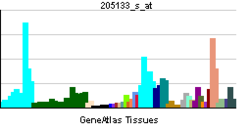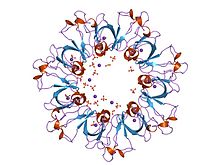- GroES
-
Heat shock 10kDa protein 1 (chaperonin 10) Identifiers Symbols HSPE1; CPN10; EPF; GROES; HSP10 External IDs OMIM: 600141 MGI: 104680 HomoloGene: 20500 GeneCards: HSPE1 Gene Gene Ontology Molecular function • protein binding
• ATP binding
• unfolded protein binding
• chaperone binding
• chaperone bindingCellular component • cytoplasm
• mitochondrion
• mitochondrion
• mitochondrial matrixBiological process • protein folding
• activation of caspase activity
• response to unfolded proteinSources: Amigo / QuickGO RNA expression pattern 
More reference expression data Orthologs Species Human Mouse Entrez 3336 15528 Ensembl ENSG00000115541 ENSMUSG00000073676 UniProt P61604 Q4KL76 RefSeq (mRNA) NM_002157.2 NM_008303.4 RefSeq (protein) NP_002148.1 NP_032329.1 Location (UCSC) Chr 2:
198.36 – 198.37 MbChr 1:
55.14 – 55.15 MbPubMed search [1] [2] Cpn10 
gp31 co-chaperonin from bacteriophage t4 Identifiers Symbol Cpn10 Pfam PF00166 Pfam clan CL0296 InterPro IPR020818 PROSITE PDOC00576 SCOP 1lep Available protein structures: Pfam structures PDB RCSB PDB; PDBe PDBsum structure summary Heat shock 10 kDa protein 1 (Hsp10) also known as chaperonin 10 (cpn10) or early-pregnancy factor (EPF) is a protein that in humans is encoded by the HSPE1 gene. The homolog in E. coli is GroES that is a chaperonin which usually works in conjunction with GroEL.[1]
GroES exists as a ring-shaped oligomer of between six to eight identical subunits, while the 60 kDa chaperonin (cpn60 - or groEL in bacteria) forms a structure comprising 2 stacked rings, each ring containing 7 identical subunits.[2] These ring structures assemble by self-stimulation in the presence of Mg2+-ATP. The central cavity of the cylindrical cpn60 tetradecamer provides an isolated environment for protein folding whilst cpn-10 binds to cpn-60 and synchronizes the release of the folded protein in an Mg2+-ATP dependent manner.[3] The binding of cpn10 to cpn60 inhibits the weak ATPase activity of cpn60.
Escherichia coli GroES has also been shown to bind ATP cooperatively, and with an affinity comparable to that of GroEL.[4] Each GroEL subunit contains three structurally distinct domains: an apical, an intermediate and an equatorial domain. The apical domain contains the binding sites for both GroES and the unfolded protein substrate. The equatorial domain contains the ATP-binding site and most of the oligomeric contacts. The intermediate domain links the apical and equatorial domains and transfers allosteric information between them. The GroEL oligomer is a tetradecamer, cylindrically shaped, that is organised in two heptameric rings stacked back to back. Each GroEL ring contains a central cavity, known as the `Anfinsen cage', that provides an isolated environment for protein folding. The identical 10 kDa subunits of GroES form a dome-like heptameric oligomer in solution. ATP binding to GroES may be important in charging the seven subunits of the interacting GroEL ring with ATP, to facilitate cooperative ATP binding and hydrolysis for substrate protein release.
Contents
Interactions
GroES has been shown to interact with GroEL.[5][6]
References
- ^ "Entrez Gene: HSPE1 heat shock 10kDa protein 1 (chaperonin 10)". http://www.ncbi.nlm.nih.gov/sites/entrez?Db=gene&Cmd=ShowDetailView&TermToSearch=3336.
- ^ Hemmingsen SM, Woolford C, van der Vies SM, Tilly K, Dennis DT, Georgopoulos CP, Hendrix RW, Ellis RJ (May 1988). "Homologous plant and bacterial proteins chaperone oligomeric protein assembly". Nature 333 (6171): 330–4. doi:10.1038/333330a0. PMID 2897629.
- ^ Schmidt A, Schiesswohl M, Volker U, Hecker M, Schumann W (June 1992). "Cloning, sequencing, mapping, and transcriptional analysis of the groESL operon from Bacillus subtilis". J. Bacteriol. 174 (12): 3993–9. PMC 206108. PMID 1350777. http://www.pubmedcentral.nih.gov/articlerender.fcgi?tool=pmcentrez&artid=206108.
- ^ Martin J, Geromanos S, Tempst P, Hartl FU (November 1993). "Identification of nucleotide-binding regions in the chaperonin proteins GroEL and GroES". Nature 366 (6452): 279–82. doi:10.1038/366279a0. PMID 7901771.
- ^ Samali A, Cai J, Zhivotovsky B, Jones DP, Orrenius S (April 1999). "Presence of a pre-apoptotic complex of pro-caspase-3, Hsp60 and Hsp10 in the mitochondrial fraction of jurkat cells". EMBO J. 18 (8): 2040–8. doi:10.1093/emboj/18.8.2040. PMC 1171288. PMID 10205158. http://www.pubmedcentral.nih.gov/articlerender.fcgi?tool=pmcentrez&artid=1171288.
- ^ Lee KH, Kim HS, Jeong HS, Lee YS (October 2002). "Chaperonin GroESL mediates the protein folding of human liver mitochondrial aldehyde dehydrogenase in Escherichia coli". Biochem. Biophys. Res. Commun. 298 (2): 216–24. doi:10.1016/S0006-291X(02)02423-3. PMID 12387818.
Further reading
- Czarnecka AM, Campanella C, Zummo G, Cappello F (2007). "Heat shock protein 10 and signal transduction: a "capsula eburnea" of carcinogenesis?". Cell Stress Chaperones 11 (4): 287–94. doi:10.1379/CSC-200.1. PMC 1713189. PMID 17278877. http://www.pubmedcentral.nih.gov/articlerender.fcgi?tool=pmcentrez&artid=1713189.
- Legname G, Fossati G, Gromo G, et al. (1995). "Expression in Escherichia coli, purification and functional activity of recombinant human chaperonin 10". FEBS Lett. 361 (2-3): 211–4. doi:10.1016/0014-5793(95)00184-B. PMID 7698325.
- Cavanagh AC, Morton H (1994). "The purification of early-pregnancy factor to homogeneity from human platelets and identification as chaperonin 10". Eur. J. Biochem. 222 (2): 551–60. doi:10.1111/j.1432-1033.1994.tb18897.x. PMID 7912672.
- Monzini N, Legname G, Marcucci F, et al. (1994). "Identification and cloning of human chaperonin 10 homologue". Biochim. Biophys. Acta 1218 (3): 478–80. PMID 7914093.
- Chen JJ, McNealy DJ, Dalal S, Androphy EJ (1994). "Isolation, sequence analysis and characterization of a cDNA encoding human chaperonin 10". Biochim. Biophys. Acta 1219 (1): 189–90. PMID 7916212.
- Samali A, Cai J, Zhivotovsky B, et al. (1999). "Presence of a pre-apoptotic complex of pro-caspase-3, Hsp60 and Hsp10 in the mitochondrial fraction of jurkat cells". EMBO J. 18 (8): 2040–8. doi:10.1093/emboj/18.8.2040. PMC 1171288. PMID 10205158. http://www.pubmedcentral.nih.gov/articlerender.fcgi?tool=pmcentrez&artid=1171288.
- Summers KM, Fletcher BH, Macaranas DD, et al. (2000). "Mapping and characterization of the eukaryotic early pregnancy factor/chaperonin 10 gene family". Somat. Cell Mol. Genet. 24 (6): 315–26. doi:10.1023/A:1024488422990. PMID 10763410.
- Richardson A, Schwager F, Landry SJ, Georgopoulos C (2001). "The importance of a mobile loop in regulating chaperonin/ co-chaperonin interaction: humans versus Escherichia coli". J. Biol. Chem. 276 (7): 4981–7. doi:10.1074/jbc.M008628200. PMID 11050098.
- Fletcher BH, Cassady AI, Summers KM, Cavanagh AC (2001). "The murine chaperonin 10 gene family contains an intronless, putative gene for early pregnancy factor, Cpn10-rs1". Mamm. Genome 12 (2): 133–40. doi:10.1007/s003350010250. PMID 11210183.
- Parissi V, Calmels C, De Soultrait VR, et al. (2001). "Functional interactions of human immunodeficiency virus type 1 integrase with human and yeast HSP60". J. Virol. 75 (23): 11344–53. doi:10.1128/JVI.75.23.11344-11353.2001. PMC 114720. PMID 11689615. http://www.pubmedcentral.nih.gov/articlerender.fcgi?tool=pmcentrez&artid=114720.
- Hansen JJ, Dürr A, Cournu-Rebeix I, et al. (2002). "Hereditary spastic paraplegia SPG13 is associated with a mutation in the gene encoding the mitochondrial chaperonin Hsp60". Am. J. Hum. Genet. 70 (5): 1328–32. doi:10.1086/339935. PMC 447607. PMID 11898127. http://www.pubmedcentral.nih.gov/articlerender.fcgi?tool=pmcentrez&artid=447607.
- Guidry JJ, Wittung-Stafshede P (2002). "Low stability for monomeric human chaperonin protein 10: interprotein interactions contribute majority of oligomer stability". Arch. Biochem. Biophys. 405 (2): 280–2. doi:10.1016/S0003-9861(02)00406-X. PMID 12220543.
- Lee KH, Kim HS, Jeong HS, Lee YS (2002). "Chaperonin GroESL mediates the protein folding of human liver mitochondrial aldehyde dehydrogenase in Escherichia coli". Biochem. Biophys. Res. Commun. 298 (2): 216–24. doi:10.1016/S0006-291X(02)02423-3. PMID 12387818.
- Strausberg RL, Feingold EA, Grouse LH, et al. (2003). "Generation and initial analysis of more than 15,000 full-length human and mouse cDNA sequences". Proc. Natl. Acad. Sci. U.S.A. 99 (26): 16899–903. doi:10.1073/pnas.242603899. PMC 139241. PMID 12477932. http://www.pubmedcentral.nih.gov/articlerender.fcgi?tool=pmcentrez&artid=139241.
- Hansen JJ, Bross P, Westergaard M, et al. (2003). "Genomic structure of the human mitochondrial chaperonin genes: HSP60 and HSP10 are localised head to head on chromosome 2 separated by a bidirectional promoter". Hum. Genet. 112 (1): 71–7. doi:10.1007/s00439-002-0837-9. PMID 12483302.
- Mansell JP, Yarram SJ, Brown NL, Sandy JR (2004). "Type I collagen synthesis by human osteoblasts in response to placental lactogen and chaperonin 10, a homolog of early-pregnancy factor". In Vitro Cell. Dev. Biol. Anim. 38 (9): 518–22. doi:10.1290/1071-2690(2002)038<0518:TICSBH>2.0.CO;2. PMID 12703979.
- Cappello F, Bellafiore M, David S, et al. (2003). "Ten kilodalton heat shock protein (HSP10) is overexpressed during carcinogenesis of large bowel and uterine exocervix". Cancer Lett. 196 (1): 35–41. doi:10.1016/S0304-3835(03)00212-X. PMID 12860287.
- Shan YX, Liu TJ, Su HF, et al. (2004). "Hsp10 and Hsp60 modulate Bcl-2 family and mitochondria apoptosis signaling induced by doxorubicin in cardiac muscle cells". J. Mol. Cell. Cardiol. 35 (9): 1135–43. doi:10.1016/S0022-2828(03)00229-3. PMID 12967636.
- Shan YX, Yang TL, Mestril R, Wang PH (2003). "Hsp10 and Hsp60 suppress ubiquitination of insulin-like growth factor-1 receptor and augment insulin-like growth factor-1 receptor signaling in cardiac muscle: implications on decreased myocardial protection in diabetic cardiomyopathy". J. Biol. Chem. 278 (46): 45492–8. doi:10.1074/jbc.M304498200. PMID 12970367.
- Guidry JJ, Shewmaker F, Maskos K, et al. (2004). "Probing the interface in a human co-chaperonin heptamer: residues disrupting oligomeric unfolded state identified". BMC Biochem. 4: 14. doi:10.1186/1471-2091-4-14. PMC 270013. PMID 14525625. http://www.pubmedcentral.nih.gov/articlerender.fcgi?tool=pmcentrez&artid=270013.
External links
Chaperones/
protein foldingOtherProtein targeting Ubiquitin E1 Ubiquitin-activating enzyme (UBA1, UBA2, UBA3, UBA5, UBA6, UBA7, ATG7, NAE1, SAE1)
E2 Ubiquitin-conjugating enzyme (A • B • C • D1, D2, D3 • E1, E2, E3 • G1, G2 • H • I • J1, J2 • K • L1, L2, L3, L4, L6 • M • N • O • Q1, Q2 • R1 (CDC34), R2 • S • V1, V2 • Z)
E3 Ubiquitin ligase (VHL, Cullin, CBL, MDM2, FANCL, UBR1)
Deubiquitinating enzyme: Ataxin 3 • USP6 • CYLD
ATG3 • BIRC6 • UFC1Other This article includes text from the public domain Pfam and InterPro IPR020818
Categories:- Human proteins
- Chromosome 2 gene stubs
- Protein domains
Wikimedia Foundation. 2010.
